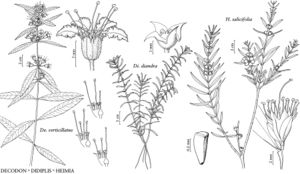Decodon
Syst. Nat. 1: 656, 677. 1791.
| Taxon | Illustrator ⠉ | |
|---|---|---|
 | Decodon verticillatus Didiplis diandra Heimia salicifolia |
Shrubs or subshrubs, aquatic, (5–) 10–30 dm, glabrous or velutinous. Stems erect or arching, branched or unbranched, spreading vegetatively by rooting from submerged tips of arching stems, submerged stems often thickened by external layers of spongy aerenchyma. Leaves opposite or 3-whorled; petiolate; blade lanceolate, base attenuate. Inflorescences indeterminate, axillary, simple or compound cymes, 3+-flowered. Flowers pedicellate, actinomorphic, tristylous; floral-tube perigynous, campanulate; epicalyx segments ca. 2 times longer than sepals; sepals (4 or) 5 (–7), to 1/3 floral-tube length; petals caducous or deciduous, (4 or) 5 (–7), rose-purple; nectariferous tissue present in lower ovary wall; stamens (8–) 10; ovary 3 (–5) -locular; placenta elongate; style slender; stigma capitate. Fruits capsules, walls moderately thick and dry, dehiscence loculicidal. Seeds 20–30, obpyramidal; cotyledons ± complanate.
Distribution
c, e North America
Discussion
Species 1.
Although Decodon is now monospecific and endemic to the central and eastern United States, it formerly had a nearly global distribution in the northern latitudes. Fossil seeds of Decodon from the Late Cretaceous (73.5 Ma) of northern Mexico represent the second oldest known occurrence of Lythraceae in the world, second only to pollen of Lythrum from the Late Cretaceous (82–81 Ma) of Wyoming. Decodon was widespread and diverse during the Miocene in both hemispheres; it became severely reduced as climates cooled in the Pliocene and thereafter, ultimately becoming restricted to D. verticillatus in eastern North America (S. A. Graham 2013).
Selected References
None.
Lower Taxa
"dm" is not declared as a valid unit of measurement for this property."dm" is not declared as a valid unit of measurement for this property.